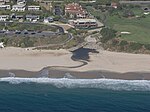Suicide of Holly Glynn
1987 deaths1987 suicidesDeaths by person in CaliforniaHistory of women in CaliforniaSeptember 1987 events in the United States ... and 1 more
Suicides by jumping in California
Holly Jo Glynn (September 11, 1966 – September 20, 1987) was a formerly unidentified American woman who committed suicide in September 1987 by jumping off a cliff in Dana Point, California. Her body remained unidentified until 2015, when concerns previously expressed by friends of Glynn that the unidentified woman may have been their childhood friend, whom they had been unable to locate for several years, were proven.Prior to her May 2015 identification, Glynn's body had been informally known as the Dana Point Jane Doe, and officially as Jane Doe 87-04457-EL
Excerpt from the Wikipedia article Suicide of Holly Glynn (License: CC BY-SA 3.0, Authors).Suicide of Holly Glynn
Scenic Drive,
Geographical coordinates (GPS) Address Nearby Places Show on map
Geographical coordinates (GPS)
| Latitude | Longitude |
|---|---|
| N 33.46155 ° | E -117.71134 ° |
Address
Scenic Drive
92629
California, United States
Open on Google Maps








